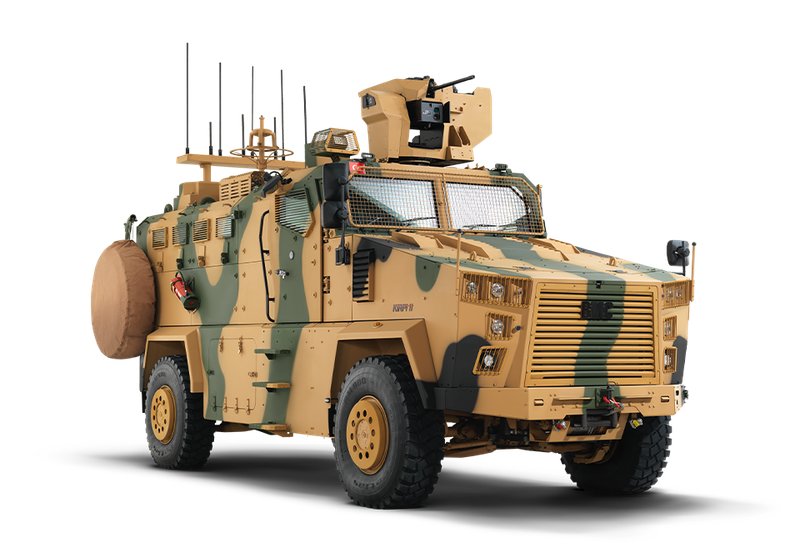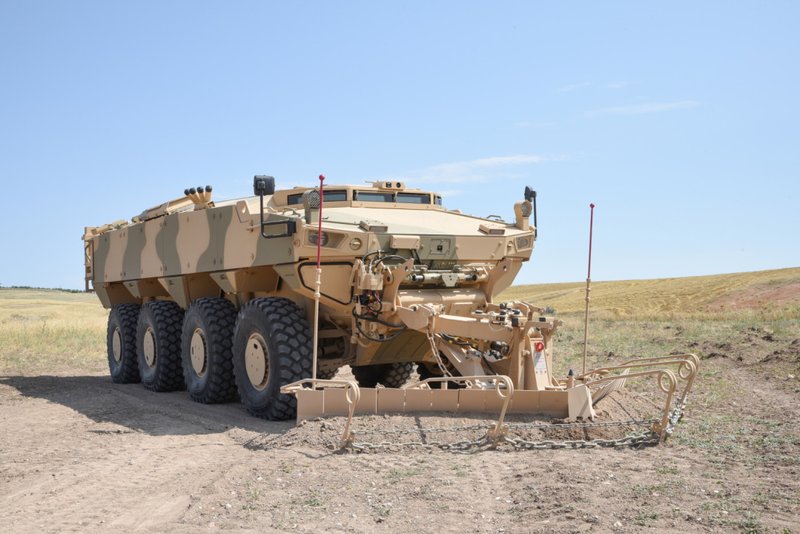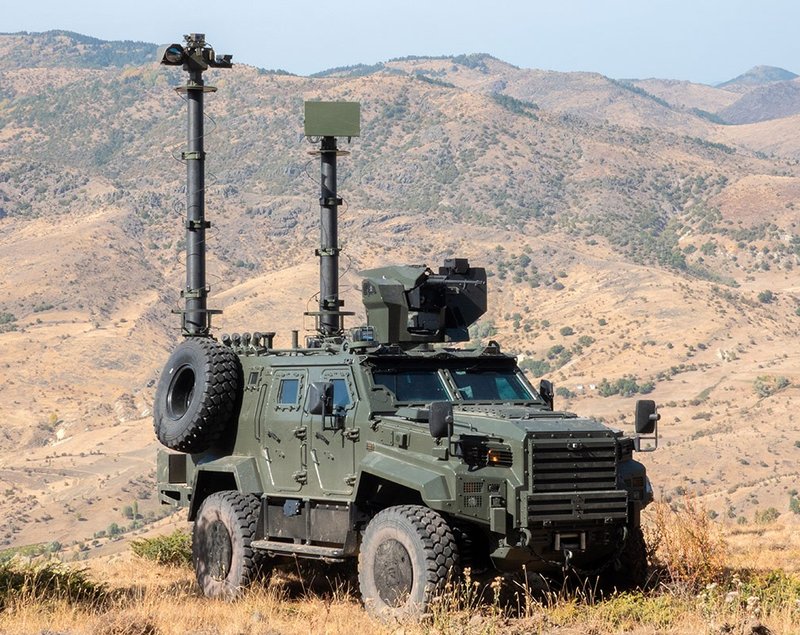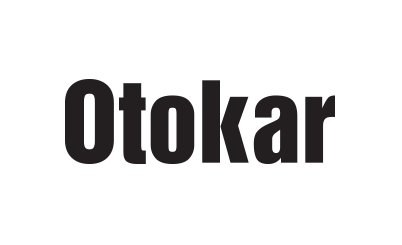Above: The latest version of Otokar's Arma 8x8 in IFV configuration with a Mizrak 30 remote-controlled turret. (Photo: Otokar)
Foss Unglossed: Tracking down the customers – where do Turkish AFV exports go?
I am told we are living in the information age but sometimes getting hold of said information can be difficult, especially where military matters are concerned.
There are many reasons to keep export contracts for combat vehicles confidential. These range from commercial sensitivity to operational security, and there’s always someone involved with the transaction who wants to keep it under wraps!
This special IDEF 2025 Shephard Views Newsletter is presented in partnership with Otokar
Lateral thinking is sometimes needed. Military parades seem to be coming back into fashion and are always worth watching as they may reveal the existence of a previously unknown type within an army’s fleet.
I also remember the days of peering at murky satellite images to try and work out if that grey blob was a previously unknown tank or missile launcher! These days you’re more likely to spot something in the background of a TikTok video shot on a soldier’s iPhone, but I will leave that particular kind of “intelligence-gathering” to a newer generation of analyst!
Turning then to my main topic, there are four main contractors for wheeled AFVs in Turkey, offering an extensive range of different platforms – so extensive that it is difficult to keep track of…

Explore armored vehicles and turret systems of Otokar, the global land systems manufacturer.
Some of these companies make their export customers public but most do not reveal any details at all for contractual reasons. Ankara supplies that much-maligned body the United Nations with the countries and number of vehicles (but not type) sold for its Arms Register, and for the last three years over 1,400 wheeled AFVs have been exported, more than any other single country. Impressive stuff, and a “number one” position that may come as a surprise.
Let’s dive deeper into the who and why of this export success. This first company in the spotlight is BMC, which was originally involved in the production of civil and military trucks but moved on to design and development of Mine Resistant Ambush Protected (MRAP) types.
Its later track(ed) record on the Altay main battle tank has been less than stellar, although most problems now seem to have been finally sorted out. I’m not the only one to point out that a manufacturer with more experience of heavy armour might have been a better fit, but that is now apparently water under the bridge and BMC may yet surprise us with how it executes volume Altay production for the Turkish Land Forces Command (TLFC).

Above: A Kipri II 4x4 MRAP fitted with remote weapon station, counter-IED devices and front-mounted winch. (Image: BMC)
MRAPs have been more BMC’s forte thus far. Its best-selling vehicle is the Kirpi (“hedgehog”), with the first order placed by Turkey for 614 units in 4x4 configuration More domestic sales have followed plus several exports, with the largest known fleet being that of Tunisia (over 200 units).
By mid-2025 around 2,000 had been built with one recent customer being Ukraine, which has used them in combat. At least two have earned the “distinction” of being captured by the Russians. Apart from the headline-grabbing TB2 drone, Turkish contributions to Kyiv’s war effort have been rather downplayed. Some sources claim as many as 700 Kirpis have or will be supplied, but that seems very high in my opinion and if true implies a major depletion of the TLFC’s own fleet.
A 6x6 Kirpi exists, with more volume and payload, and BMC also produces the more compact Vuran and Amazon MRAPs.
More recently the company developed the Altug 8x8 infantry fighting vehicle (IFV) with an initial contract for 29 placed by the TLFC, all of which will be fitted with Aselsan’s SARP remote-controlled turret (RCT) armed with a 35mm cannon.
Another established Turkish 8x8 family also exists in the form of FNSS’s Pars (a kind of leopard) series, which also includes 4x4 and 6x6 models. Having firmly established itself as a supplier of tracked AFVs with the TIFV/ACV line, the company turned to development of a wheeled platform in 2004.
The baseline Pars evolved from designs by US firm General Purpose Vehicles but incorporates many enhancements as well as locally designed subsystems. The first export success for the second-generation Pars II came from Malaysia which eventually took 258 under the local name AV-8 Gempita (“thunder” – apparently leopards are persona non grata in Kuala Lumpur!) Its first vehicles came from Turkish production but most were built locally under a major technology transfer.
The second export customer was Oman which took delivery of 145 8x8s and 27 6x6s across multiple versions. FNSS also provides through-life support for exported vehicles plus training for crews and maintainers, but these are just “table stakes” these days.
All this was followed by a major order from the TLFC for Pars IV Special Forces Vehicles and the Pars Scout in 8x8 and 6x6 Special Purpose Reconnaissance Vehicle versions.
FNSS also recently landed a further TLFC contract for series production of the Pars Alpha under the New Generation Wheeled Armoured Vehicle effort, where it will apparently serve alongside the not-dissimilar albeit somewhat heavier BMC Altug (around 30t versus 35t).

Above: An FNSS Pars III 8x8 as supplied to the Royal Army of Oman, seen fitted with a Pearson Engineering mine plough. (Photo: FNSS)
Our next supplier, Otokar, made its first forays into the combat vehicle market using Land Rover and later HMMWV chassis and components as the basis. All told, it has sold wheeled vehicles to 70 users in 40 countries, and in recent years almost all production has been for export.
Otokar has long since moved on to developing its own vehicles using internal R&D funding. The original Cobra (which used HMMWV parts) has been followed by the Cobra II which has more volume, payload and protection as well as greater mobility.
Its latest customer is Romania which will take delivery of 1,049 with first 278 coming from Turkey and remainder manufactured locally by joint venture (JV) SAROM, which was established in June 2025. I think this is significant – a four-figure order from a NATO country which not so long ago would have been regarded as a shoo-in for the HMMWV itself or the JLTV (Romania has ordered the latter too, but only a small batch for special forces, who usually get exactly what they want!)
According to Otokar “local integration has begun in Romania and SAROM is moving full speed ahead for full production.” Can this success be repeated elsewhere in NATO as everyone scrambles to re-arm? I’d say the likelihood is high.
Export customers are also demanding AFVs with more volume, payload and protection, which has led to the development of Otokar’s Arma family in 6x6 and 8x8 configurations
These have been sold to at least nine users in five countries, including Bahrain and Estonia, but Otokar is unable to provide confirmation or further details due to confidentiality.
In May 2025 some Otokar vehicles were seen in a military parade in Astana, Kazakhstan including Arma 8x8s fitted with a Chinese NORINCO turret armed with a 100mm gun plus 30mm and 7.62mm coaxial weapons and an ATGW mounted externally either side. More details will doubtless emerge of this programme but we may have to keep parade-watching to find them!
The Arma 8x8 has a gross vehicle weight (GVW) of 28-35 tonnes, and supports up to 105mm main armament. Otokar offers its own turrets and remote weapon stations with a good example being the Mizrak RCT which is typically armed with a 30mm Northrop Grumman MK44 Chain Gun plus the inevitable 7.62mm coaxial MG.
The company has also supplied the UAE with some 400 Rabdan 8x8 vehicles which were fitted with turrets taken from Russian BMP-3 IFVs armed with a 100mm main gun, proving that NATO and Warsaw Pact standard technology can be combined if you try hard enough!
Its latest 8x8 is the Arma II, launched in 2023 with a maximum GVW of 40 tonnes. This ups the weapons ante further with the option of a turret-mounted 120mm smoothbore gun and has two engine options.
In IFV configuration it carries three crew plus nine dismounts and has also been shown in the air defence role fitted with an Aselsan RCT armed with twin 35mm cannon.
Otokar has also developed the Ural 4x4 which is aimed more at the police and internal security markets. This is typically fitted with a remote or protected weapon station and has a more “non-aggressive” appearance than some other vehicles of its type. Known users include Turkey as well as Bahrain, Ecuador, Ivory Coast and Turkmenistan, but Otokar is unable to confirm these due to confidentially.
The company has also invested in hybrid-electric drives with its Akrep II 4x4 reconnaissance vehicle, but like other contractors there has not been significant interest across key export markets. While it may be premature to say that sustainability in defence is dead, it does seem to be taking a long cigarette break at the moment!

Above: The Ejder Yalcin can be adapted for a wide range of missions. This is a battlefield surveillance vehicle equipped with radar and mast-mounted sensors. (Photo: Nurol Makina)
IOur last major manufacturer, Nurol Makina, is focused on 4x4 tactical vehicles but also provides armour systems and gunner cupolas to sister company FNSS for installation on IFVs and other export products.
To accommodate different user requirements its product range includes the 18-tonne Ejder Yalcin, 13-tonne NMS, 10-tonne NMS-L and 7.5-tonne IIgaz 2. There is also the 13-tonne Pars 4x4. Now that the parent Nurol Holding is in the process of becoming sole owner of FNSS we might see some changes in “badging” soon.
The company has provided 174 of this Pars model to FNSS which then fitted its Anti-tank Remote Controlled Turret before delivery to the TLFC.
By mid-2025 Nurol Makina had built over 1,800 vehicles with sales to more than 40 countries worldwide. According to the company its flagship product is the Ejder Yalcin (“dragon”), which it describes as a “combat-proven vehicle which has been actively deployed in high-intensity conflict zones.”
In addition to its primary mission as a troop carrier, the Ejder Yalcin can serve as an 81mm or 120mm mortar platform, border surveillance and security vehicle, air defence vehicle, reconnaissance vehicle, command and control platform, mine/IED detection and clearance vehicle, CBRN platform and battlefield ambulance.
Like Otokar, Nurol Makina is branching out into Europe. A local version of the Ejder Yalcin called Gidran (a breed of horse, dragons do not travel well either apparently) is now being produced in Hungary through a JV between Nurol and Raba Automotive.
The first batch of more than 100 was produced in Turkey while subsequent units are being assembled at Raba’s Hungarian facilities and fitted with Aselsan’s SARP RWS. Hungary reportedly has an overall requirement for more than 300.
In 2023 Nurol Makina further extended its reach to the British Isles with the establishment of NMS UK as a protected mobility vehicle supplier, combining its proven expertise this field with British engineering (or what is left of it!)
Through NMS UK, the company hopes to secure business from the British Army’s project to replace a significant number of its legacy vehicles. To improve its chances Nurol Makina has already established an eight-acre manufacturing centre in exotic Leamington Spa.
NMS UK is pitching vehicles for the Light and Medium UK Protected Mobility requirements, offering the NMS-L for the former and the larger Dragon (ie Ejder Yalcin) for the latter. Apparently we Brits can handle Turkish dragons even if the Hungarians can’t! It must be something to do with St George.
As can be seen, Turkey’s wheeled AFV exports are impressive, even if many details of who ordered what are opaque. But this is where we defence pundits really earn our meagre pay packets! The true geniuses among us will of course correctly predict the order before the requirements document is even written.
While the customer breakdown (where known) is still dominated by MENA, but with solid business also in sub-Saharan Africa, plus Central and Southeast Asia, the Romanian and Hungarian contracts for licence-built 4x4s show that a westward-directed export drive can usurp some former usual suspects. If Nurol Makina succeeds in adding the British Army to its list of (hopefully) satisfied customers, then who knows what the export breakdown submitted to the UN will look like ten years from now!











